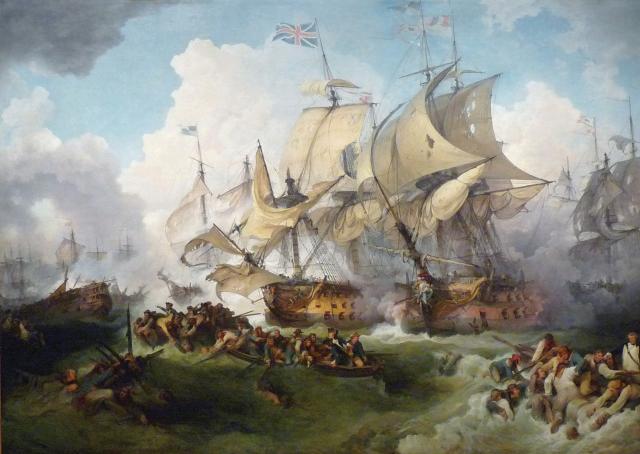Showdown on the ‘Glorious First of June’
The soaring ideals of the French Revolution had devolved into the bloody misrule of the Reign of Terror by the spring of 1794. Revolutionary France was beset by enemies on all sides, dissension from within, and, looming above it all, the specter of famine.
A bad crop harvest and a disrupted countryside had led to perilous food shortages. The threat of a starving France was the threat of a failed Révolution. All hope rested on a massive grain convoy being assembled in the United States for the transatlantic crossing. That grain had to get through at all cost—and so it fell to the French navy, the Marine Nationale, to rescue Revolutionary France from its impending doom.
But to cross the Atlantic, meet the eastbound convoy, and escort it homeward, the French fleet would have to play cat-and-mouse the whole way with the most powerful sea force in the world—the Royal Navy. England and France, the age-old foes, were freshly at war again—a protracted state of conflict that, this go-round, would last until 1815, as France lurched violently from post-revolutionary upheaval to the meteoric rise, then ignominious fall, of Napoleon.
Shielded by a blanketing fog, the “Grand Fleet of France” departed Brest on 16 May under the command of Contre-Amiral (Rear Admiral) Louis Thomas Villaret de Joyeuse. The Royal Navy’s Channel Fleet, under the command of Admiral Richard, Lord Howe, was in hot pursuit from the outset; on the 17th, the two fleets actually passed one another in the fog, both sides unaware.
By 28 May, Howe’s advance flying squadron had spotted the French fleet. On 29 May, the adversaries clashed, but thick fog and descending night curtailed the action. On 1 June, dawn came clear, and the stage was set for the Age of Fighting Sail’s only fleet engagement fought on the wide-open ocean, some 400 miles from the nearest landmark. It became best known, then, not by a geographic descriptor, but by the date on which it was fought—the Glorious First of June.
The rival fleets—26 French ships-of-the-line versus 25 British ships-of-the-line—were sailing westerly, parallel, the British to windward, when Howe undertook an audacious ploy: He ordered his ships to veer individually from the line of battle and turn straight into the French line, raking the enemy ships while passing between them, then cutting them off from escape to leeward. Only seven of his captains obeyed him and maneuvered as ordered—but even that was enough to devastate the French formation, and the fight quickly became a melee of brutal close-quarters ship-on-ship slugfests.
Howe’s flagship, HMS Queen Charlotte, crossed the stern of the French flagship Montagne, unleashing a broadside that thundered down the length of the enemy’s deck, killing 100 and wounding 200 with one volley. HMS Bellerophon—famously nicknamed the “Billy Ruffian”—took on both the Éole and Trajan, bested them with superior British gunnery, and sent them fleeing. But the Bellerophon had taken her share of hits; her fore and main topmasts were shot down, and her captain, Rear Admiral Thomas Pasley, lost a leg. Thus it fiercely went all along the broken French line for the better part of an hour—and then it was over.
Howe had lost not a single ship, while 12 French ships were captured or destroyed. The British had suffered fewer than 1,200 casualties (including 290 killed), while some 2,500 French were killed, 5,000 wounded, and 4,000 taken prisoner.
The battered remnants of Villaret de Joyeuse’s fleet sailed away. History always will wonder what would have happened had the exhausted British fleet pressed its advantage and pursued them.
It had been a resounding British victory—but ultimately, the French grain convoy did get through. Years of warfare would ensue until, in the end, a defeated Napoleon was hauled off to live out his life as a prisoner—and the ship that would carry the vanquished arch-enemy from France was none other than . . . Billy Ruffian— the Bellerophon herself, which had been there at the beginning of it all, on that Glorious First of June.
Sources:
William James, The Naval History of Great Britain, from the Declaration of War by France in 1793 to the Accession of George IV (London: Richard Bentley & Son, 1886), vol. 1, 138–99.
Mark Lardas, The Glorious First of June 1794 (Oxford, UK: Osprey, 2019).
Alfred Thayer Mahan, The Influence of Sea Power upon the French Revolution and Empire, 1793-1812 (Boston: Little, Brown and Company, 1893), vol. 1, 122–61.
Peter Padfield, Maritime Power and the Struggle for Freedom: Naval Campaigns that Shaped the Modern World, 1788–1851 (New York: Abrams Press, 2005), 72–105.











